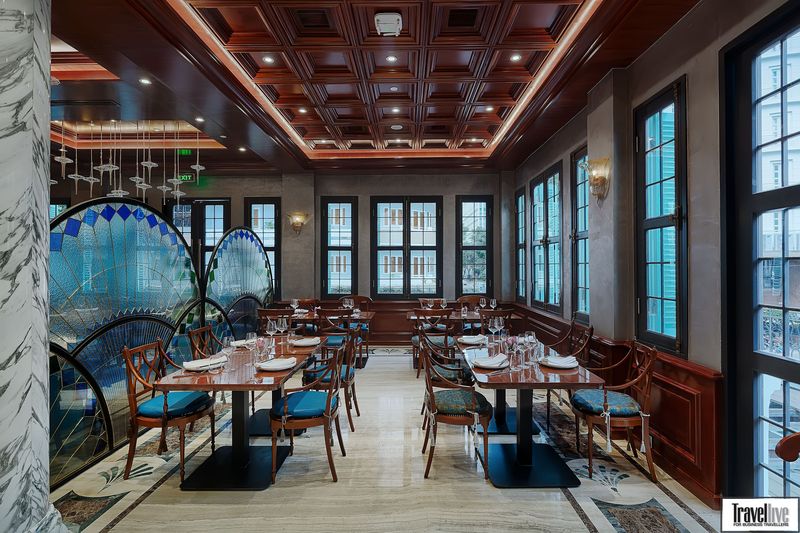The Legend of Auguste Escoffier and the Birth of Fine Dining
The concept of 'restaurants' actually only started in the late 1700s, during the French Revolution. 'Restaurants' were originally just dining areas in inns for the common people, while the aristocracy always had a private chef serving them at home. Only those who cooked for royalty and the aristocracy were skilled enough to be called chefs. It wasn't until the French Revolution that the aristocracy collapsed, and talented chefs became unemployed. At this time, they began to look for work in restaurants, and offered a more extensive menu of more complex dishes, instead of just serving diners a simple soup like before. This was the beginning of 'fine dining' restaurants.
The high-end cuisine 'fine dining' was developed and popularized in the world in the early 20th century thanks to the culinary legend Auguste Escoffier (1846-1935) - the father of contemporary fine dining (The Father of Haute Cuisine). Famous for simplifying and refining French cuisine, he also invented the classic sauces of today: tomato sauce for pasta, espagnole brown sugar sauce for BBQ dishes, béchamel sauce for fish and chicken, and hollandaise cream sauce for eggs.
_result_result.jpg_5.jpg)
Instead of serving all the dishes ordered at once as people have always done, Escoffier separated the dishes and served them a la carte, as we are familiar with today. This way, the food did not become messy and overflowing on the table. He also introduced the Brigade kitchen management system, where each chef (Chef de Brigade) was responsible for a part of the work, such as Saucier: the chef in charge of making sauces, Rotisseur and Grillardin: grilling meat, Poissonier: preparing fish. The bookLe Guide CulinaireIncluding more than 5,000 menus made by Escoffier, it is still an encyclopedia in the culinary world.
Indeed, as German Emperor Kaiser Wilhelm II once said after being served by Escoffier aboard the SS Imperator:“I am the king of Germany, and you are the king of cuisine!”, tEscoffier's talent went beyond the borders of France, the fine dining style he developed gradually approached other cultures from Europe to Asia. At this time, enjoying a fine dining party was not simply about feeling the taste of dishes prepared by top chefs, but also a refined, polite lifestyle, not for those in a hurry.
Fine Dining in Vietnamese Culture
Vietnamese culture is not lacking in high-class banquets, but traditional Vietnamese banquets are often elaborate, meticulous and complicated from the preparation of ingredients to decoration, presentation and enjoyment. Street foods that are loved by world culinary enthusiasts such as bread, rice cakes, and tofu in sugar water rarely appear on large banquet tables. Therefore, when accepting the spirit of "simplifying everything" in international high-class cuisine, these familiar, simple dishes are gradually added with new variations. It is easy to understand why one of the most popular culinary trends in Vietnam today isfine diningVietnamese dishes in international style.
One of the notable places to experience the fine dining style of Vietnamese cuisine is Vietnam House. The house was built in 1910, bearing the classic beauty of the Indochine period with a hand-pulled elevator, a porch, and light blue wooden windows on a yellow brick wall. Vietnam House introduces diners to both delicious street food and traditional regional recipes with modern, interesting variations under the guidance of Chef Luke Nguyen, an Australian chef of Vietnamese origin, known to many for the success of the Red Lantern Vietnamese restaurant chain in Surry Hills, author of the books Secrets Of The Red Lantern, The Songs of Sapa, Indochine, Luke Nguyen's Greater Mekong and The Food Of Vietnam and host of programs on Vietnamese cuisine, as well as how to enjoy traditional Vietnamese cuisine and the Mekong River region.
High-quality ingredients are the distinctive highlight that creates a unique mark for Vietnam House, as Chef Luke Nguyen shared, he chooses familiar dishes that are loved by many people, and puts in new variations to elevate the dish, such as Goi Cuon with Norwegian Salmon, black sesame, dill and caviar; or Banh Dap with premium Iberico pork, handmade purple rice vermicelli, shrimp, or Bo Kho with Australian beef, accompanied by rosemary mushrooms and Italian black truffle...
Vietnamese cuisine does not tend to be aesthetically pleasing like French or Japanese cuisine, but focuses on the delicate mixing of spices to make the dish delicious. Whilefine diningemphasizes the delicate, elegant beauty of small details combined with harmonious colors. Therefore, dishes at Vietnam House, although extremely simple such as vegetarian fried rice noodles with vegetables, asparagus, and sweet cabbage, are still delicately presented, so that the decorative colors are in harmony with the flavors.
Not only that, you can easily recognize that the recipes in the fine dining menu here are the result of careful calculation about which dishes are served first and which are served later so that the meal is not just a meal of meat, but a combination of main dishes, side dishes, between the richness of meat, starch with the light, refreshing taste of green vegetables, soup, etc. Building a high-class taste feast, Vietnam House elevates Vietnamese dishes by applying the basic elements of the classic French fine dining menu, while at the same time transforming to create a unique personality, promoting the quintessence of traditional culinary recipes, constantly surprising those who love Vietnamese cuisine.
-VNH_result_result.jpg_4.jpg)
Lesson: Bamboo






































